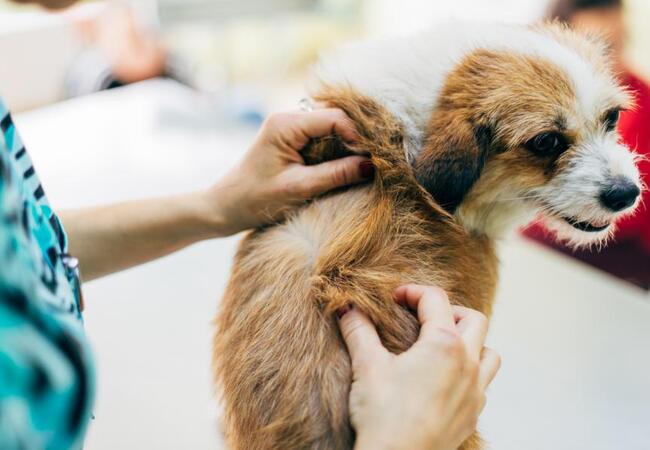Walking Dandruff” & Dandruff in Dogs: Veterinary Guide & Care 2025 🩺🐾

In this article
Walking Dandruff” & Dandruff in Dogs: Veterinary Guide & Care 2025 🩺🐾
By Dr. Duncan Houston BVSc
Hi, I’m Dr Duncan Houston BVSc, veterinarian and founder of Ask A Vet. Dandruff in dogs—especially the notorious “walking dandruff” caused by mites—can be both unsightly and uncomfortable. In this expert 2025 guide, we'll explore what different types of dandruff mean, how to spot them, perform proper diagnostics, implement treatment, and support your pet at home. We’ll also highlight how Ask A Vet tools can help through every step. Let’s dive in with confidence! 🐶💙
1. Types of Dog Dandruff: What You Might See
- Seborrhea sicca – dry, white flaky scale; often mild.
- Seborrhea oleosa – oily, greasy flakes and sometimes odor.
- Walking dandruff (cheyletiellosis) – white flakes that move; due to Cheyletiella mites.
2. Common Causes & Risk Factors
- Parasites: Cheyletiella mites cause moving flakes and can be transmitted to humans.
- Allergies: Environmental or food allergies often accompany dandruff.
- Infections: Bacterial or fungal overgrowth can lead to flaky or crusty skin.
- Hormonal issues: Hypothyroidism or Cushing’s disease commonly cause dandruff and coat problems.
- Environmental factors: Dry indoor air, seasonal changes, harsh bathing can strip oils.
- Nutrition: Vitamin or omega‑fatty acid deficiencies can contribute to poor skin health.
- Idiopathic seborrhea: When no cause is identified, this is labeled idiopathic—regardless, treatment often helps.
3. Recognizing the Signs
- White or greasy flakes are visible on coat – especially along the back and tail.
- Flakes that “move” or detach and move across the coat – classic sign of Cheyletiella mites.
- Itching, scratching, redness, hair loss, odor may accompany dandruff.
- Symptoms are sometimes seasonal or linked to specific activities or environments.
4. Diagnosis & Vet Evaluation 🔬
- History & examination: Duration, grooming habits, indoor climate, diet changes.
- Skin scrapings/flea combing/tape prep: Identify Cheyletiella mites.
- Microscopic cytology: Detect bacterial or fungal infections.
- Blood tests: Screen for thyroid, adrenal, and endocrine disorders.
- Allergy work‑up: Food trial or intradermal testing if suspicions arise.
- Breed predisposition: Some breeds like Cocker Spaniels and Bassets Hounds are prone to primary seborrhea.
5. Treatment Plans 🛠️
A. For Cheyletiella (“Walking Dandruff”)
- Weekly medicated baths or dips (lime-sulfur, pyrethrin, fipronil, imidacloprid).
- Oral/topical ivermectin, selamectin, milbemycin—vet may use off-label.
- Treat all pets and clean bedding, carpets thoroughly.
- Treatment typically takes 3–4 weeks for resolution.
B. For Dry or Oily Seborrhea
- Medicated shampoos (oatmeal, ketoconazole, antiseborrheic)—2–3× weekly.
- Moisturizing baths, balms, or wipes to restore skin barrier.
- Omega‑3/6 fatty acid supplements to support skin health.
- Treat bacterial or fungal infections as detected.
- Address hormonal disorders like hypothyroidism or Cushing’s ﹘ refer for endocrine therapy.
6. Prognosis & Recovery 📊
- Poorly managed dandruff will persist or worsen; proper treatment yields improvement in 2–4 weeks.
- Cheyletiellosis generally resolves fully with consistent treatment and environmental hygiene.
- Idiopathic or mild seborrhea manageable long-term; chronic conditions need ongoing care.
7. Prevention & Home Care 🏡
- Regular grooming: weekly brushing to distribute oils and prevent flakes.
- Bath using gentle or medicated shampoo as advised.
- Use humidifiers in dry climates/seasons.
- Provide a balanced diet with omega fatty acids.
- Maintain parasite prevention for mites and fleas.
8. Ask A Vet 💡
- Ask A Vet: Remote skin evaluations, scrub/shampoo recommendations, parasite identification, follow-ups.
9. When to Call the Vet 🚨
- Flakes cling in clumps, severe itching or odor, hair loss, redness, or crusting.
- Flakes appear to “walk” or multiple pets are affected.
- Signs of systemic illness: lethargy, appetite loss, weight change.
- No improvement after 2 weeks of home care or treatments.
10. Final Thoughts 📝
Dandruff in dogs is a common, often treatable skin concern. Whether it’s a simple matter of dry skin or the more alarming walking dandruff caused by mites, early diagnosis and tailored care lead to healthier skin and happier pups. With expert tools from Ask A Vet, supportive grooming from , you’re well-equipped to manage and prevent dandruff in 2025. 🐾💙
If your pup has persistent flakes, itching, or visible mite activity, book a telehealth consult via AskAVet.com. Download our app for personalized follow-up care and reminders. 🌟






